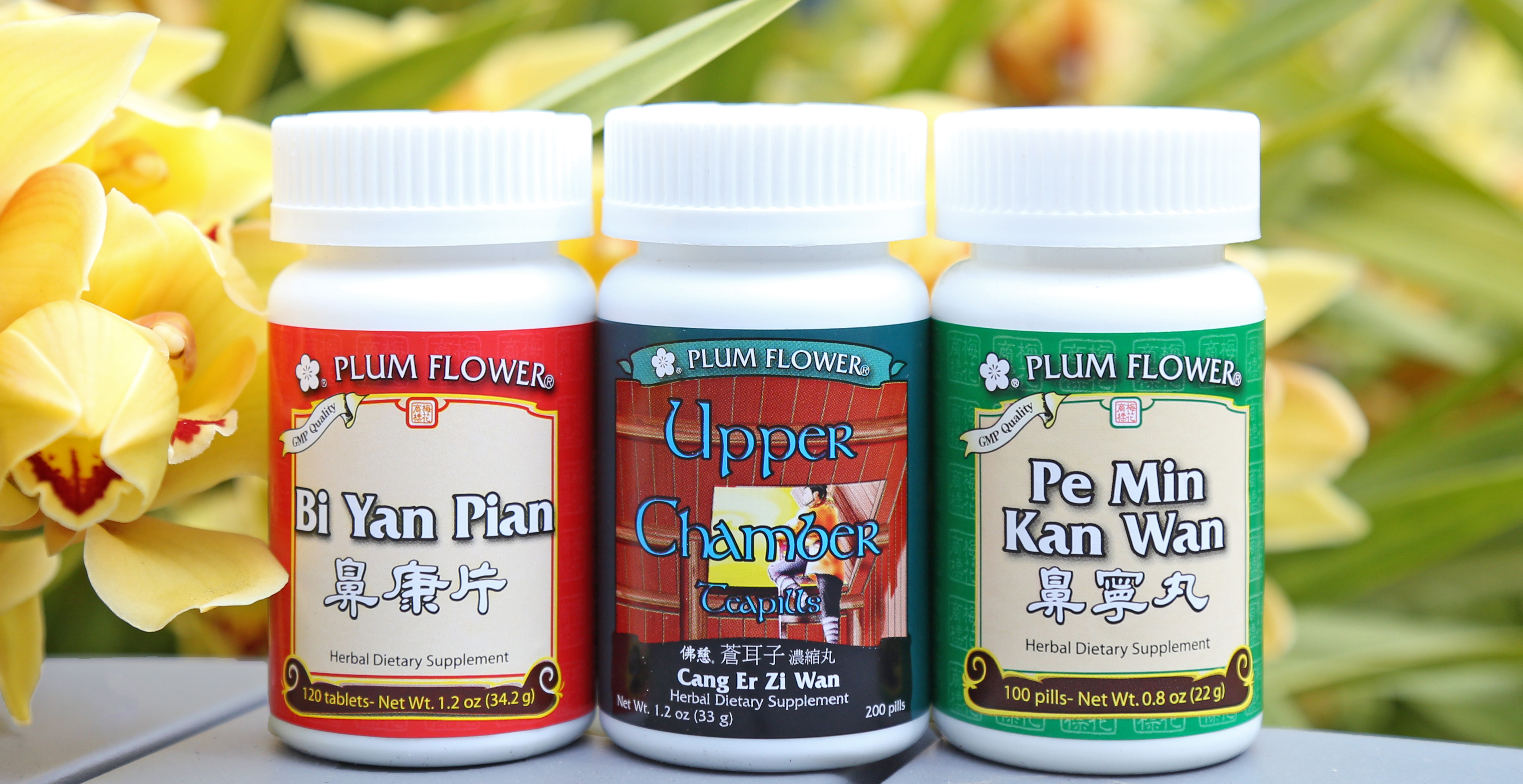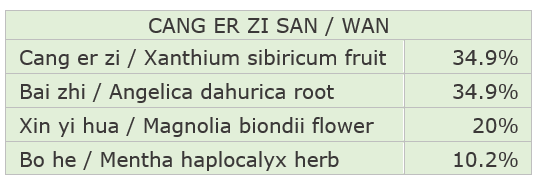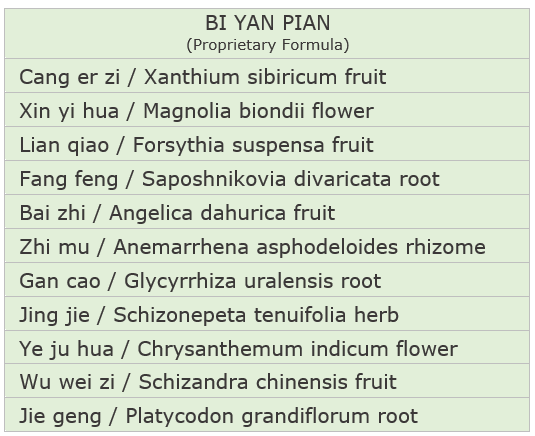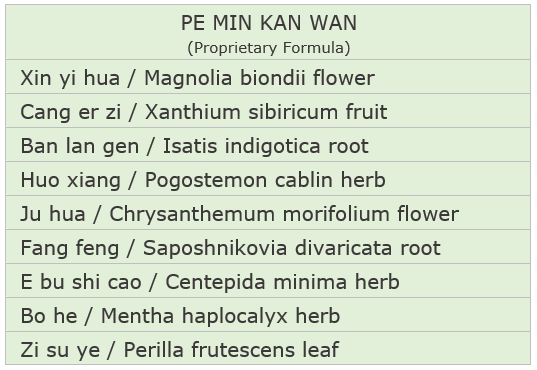3 Spring Formulas
 Originally published March 9, 2021
Originally published March 9, 2021
With spring just around the corner, it's time to get ready for more time outdoors! Along with warmer days, fresh green grass and blooming flowers, as clinicians it's time for us to prepare for our patients presenting with common seasonal sinus and nasal complaints.
Here are three helpful springtime formulas from Plum Flower® for the sensitive nose!
Upper Chamber Teapills / Cang Er Zi San
This classic herbal prescription first appeared in Formulas to Aid the Living in 1253, and is intended for sinus and nasal discharge associated with external Wind Heat. Even though the prescription is predominantly warm, it is said to clear Heat by its ascending and dispersing nature, which corresponds to the Nei Jing adage: "For Fire from constraint, discharge it."
The chief herbs Cang er zi and Xin yi hua have a unique synergistic effect. The sweet, bitter and warm Cang er zi disperses Wind and Dampness, opens the nasal passages, clears exterior Wind, and can also be used to disperse Wind-Damp Bi. In this formula, Cang er zi functions to dredge the deeper layers of the sinus and nasal passages. Since Xin yi hua is spicy and warm, it can expel Wind and open the nasal passages through its light, aromatic and ascending nature. Together, Cang er zi dredges the deeper congestion and stagnation, while Xin yi hua clears the more superficial layers and aromatically opens the nasal passages.

As deputy, the spicy, warm and aromatic Bai zhi opens the nasal orifices, disperses stagnation and dispels phlegm accumulation. Finally, as the assistant, the spicy, cool, and aromatic Bo he disperses Wind Heat from the surface, clears the head and eyes, and benefits the throat.
Cang Er Zi San is best suited for the treatment of acute Wind Heat with Phlegm accumulation in the sinuses and nasal passages. Due to the small number of herbs in the formula, it is especially strong and combines very well with other External Wind Heat formulas to address other aspects of this presentation.
For persistent Wind Heat sinus and nasal obstruction with yellow phlegm, the addition of Gan Mao Ling, Ban Lan Gen Pian or Chuan Xin Lian Pian is recommended to eliminate Toxic Heat accumulation. Additionally, this prescription is also effective for chronic Wind Cold Damp obstructing the sinuses and nasal passages. Long term continuous use of Cang Er Zi San is not recommended, since the combination can dry out the mucus membranes. In this case, consider Bi Yan Pian or Pe Min Kan Wan.
Dosage: 8 pills, 3 times daily. For herbal granules, 3 grams 3 times daily. Cautions & Contraindications: Use with caution in Yin deficiency. Cang er zi/Xanthium can be very drying, which may dry the mucus membranes and cause headache or nausea if used excessively. Use with caution during pregnancy.
Bi Yan Pian
Bi Yan Pian is a relatively modern addition to the TCM formulary, and can be used to treat acute, sub-acute or chronic Wind Heat sinus and nasal obstruction patterns.
Suitable for congestion and irritation of the sinus and nasal passages, Bi Yan Pian disperses Wind, clears Heat, transforms phlegm, expels toxins, and opens the sinus and nasal passages. It specifically addresses sub-acute and chronic stagnation of Wind and Heat in the sinuses and nasal passages, with lingering swelling, stuffiness, occasional pain and discomfort of the nasal cavity, loss of sense of smell, and sinus congestion.

The combination of Cang er zi, Xin yi hua, and Bai zhi open, dredge and clear the sinus and nasal passages, while the cold and bitter Lian qiao and Ye ju hua clear Heat and eliminate toxic Heat. Cold and sweet Zhi mu clears Heat and moistens the sinus and nasal mucosa. The pair Jing jie and Fang feng open and harmonize the exterior, and clear any persistent external Wind-Heat. Jie geng benefits the throat and nasal mucosa, and restores the normal circulation of the Lung Qi. Finally, Wu wei zi reduces swelling of the sinuses and nasal membranes.
Because Bi Yan Pian has ingredients that eliminate toxins, moisten sinus and reduce irritation of the nasal tissue, it can be used for longer periods of time without concern for over-drying the sinuses and nasal passages. This hugely popular formula is best suited for addressing congestion and Heat signs, rather than for excess Phlegm from external invasion.
Dosage: 3-4 tablets, 3 times daily. In severe cases or in the initial phases of treatment, dosage may be increased to 4-6 tablets every 2-4 hours, then reduced to a maintenance dose once treatment takes effect. May be used medium term for a few weeks to a few months. For longer term difficulties or in cases of toxin sensitivities a constitutional prescription may be indicated. Cautions & Contraindications: Use with caution in Yin deficiency. Cang er zi/Xanthium can be very drying, and excessive use may dry the mucus membranes or cause headache or nausea. Use with caution during pregnancy.
Pe Min Kan Wan
Pe Min Kan Wan is another modern formula, and was specifically created to treat environmental sensitivities leading to sinus and nasal congestion, sneezing, and copious nasal discharge. The formula disperses Wind, clears Heat, eliminates Toxins, transforms Phlegm, and opens the sinus and nasal passages.

Though the prescription ingredients look similar to Bi Yan Pian, there are some noteworthy differences. Xin yi hua, Cang er zi, and Fang feng are common to both, but the addition of Ju hua and Bo he adds a spicy cool quality to this formula, assisting to reduce mild swelling of the sinus and nasal passages while also clearing heat. The bitter and cold Ban lan gen also aids these herbs in clearing toxic Heat and swelling. The aromatic herbs Huo xiang and Zi su ye awaken the Spleen to remove congested fluids in the upper respiratory tract, while also clearing dampness from the sinus and nasal passages. Finally, Ban lan gen and E bu shi cao function together to disperse external Evil Qi, eliminate toxic Heat, and restore normal functioning of the nasal mucosa. Again, the formula is best suited when these symptoms present with associated seasonal or environmental sensitivities.
Dosage: 6 pills 3 times daily. In acute or severe cases, dosage may be increased to 7-10 pills every 2-4 hours, then reduced to a maintenance dose as the treatment takes effect. May be used medium-term for a few weeks to a few months. It may be administered along with a constitutional prescription for several month to address chronic sinus and nasal congestion. Cautions & Contraindications: Use with caution during pregnancy and Yin deficiency. Cang er zi/Xanthium can be very drying, and excessive use may dry the mucus membranes or cause headache or nausea. Use with caution in hemorrhagic disorders or with patients on anti-coagulant therapy.
Closing Comments
As with all clinical cases, making a careful differentiation of the TCM pattern diagnosis is essential to provide your patients with the most effective treatment for a variety of seasonal or environmental sinus and nasal symptoms. As the weather warms and your patients venture out into the world again, acute external Wind Heat, persistent Wind Heat, and environmentally aggravated nasal obstruction syndrome patterns will likely become more common. Help them better enjoy the season and the outdoors by addressing these syndrome patterns and underlying conditions.
You can also learn more about two of the common spring formula herbs Cang Er Zi and Xin Yi Hua in our Herbalist Corner Video!
References
- Bensky, D. et al., Chinese Herbal Medicine Materia Medica, 3rd ed., Eastland Press: 2004.
- Fratkin, J. P., Essential Chinese Formulas, Shya Publications: 2014
- Chen, J. & Chen, T., Chinese Medical Herbology and Pharmacology, Art of Medicine Press: 2004.
- Maclean, Will, Clinical Manual of Chinese Herbal Patent Medicines, Pangolin Press: 2003
- Wrinkle, A. et al., A Practitioner’s Formula Guide, Elemental Essentials Press: 2008.


